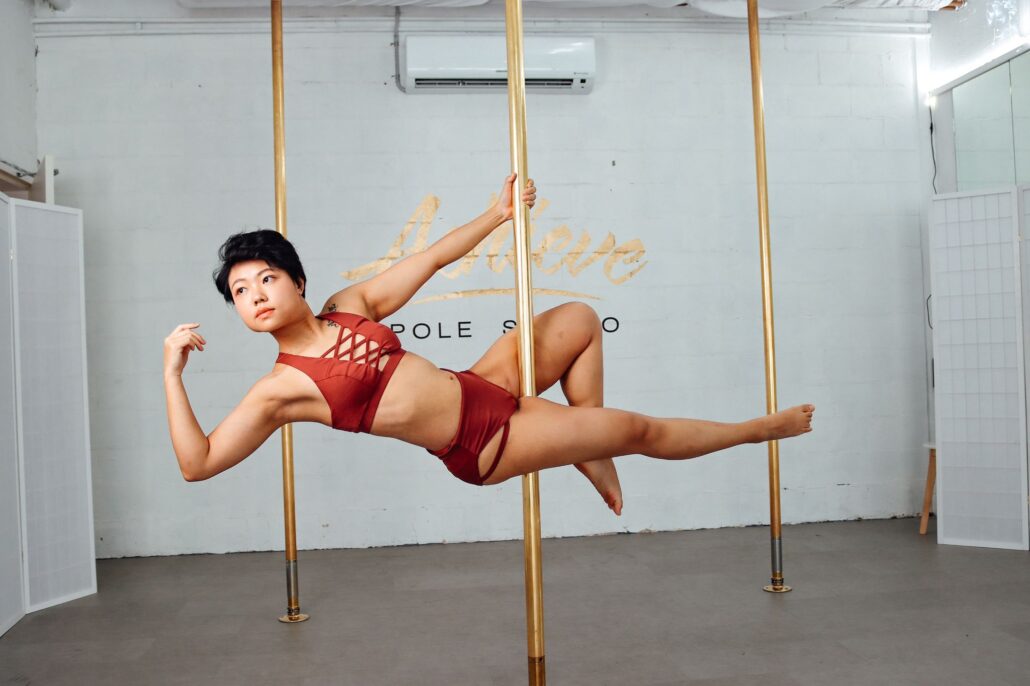
If you are an O.G. Achiever, who has been with us since their first ever beginner pole class, then you are very familiar with static pole. Some hate it, some fear it, some grit their teeth and bear it but from someone who has learned to love it, let me tell you a little bit about the magic of static pole.
Let me start by telling you that I was not always a fan of le pole statique. I remember shuddering at the thought of the grip, the way I would find a shape and then slowly sink to the side as I fought to maintain myself rigid, in line with the rigidity of the apparatus. I associated static pole with all of the skin burning and failed attempts at ragdolls and I watched with awe as I saw people like Marlo Fisken slither around a static pole like a mythical creature.
Then one day, Andrea showed me a static rotation. It was no longer about finding a move and holding on for dear life like I did on spin, or marking my wrists with suspicious cuff-shaped burns as I flung my body around the pole helplessly flailing my legs and wondering if I could ever get a Phoenix…
Suddenly the world of pole took on a fifth dimension. I not only had to get the shape, extension, activation, the push-pull, the 45-degree angle, the correct handgrip, the rotation of the heart up to the sky… I also now had to re-negotiate my response to gravity.
Because static FLOW is a practice unto itself. If you have ever been carried away by the beat and thrown yourself into dance, run downhill so fast it felt like flying, or caught Whitney’s “you” at just the right pitch in your car, then you know the feeling. You step around the pole and if you lean out just far enough, you can float gracefully around in a series of beautiful shapes that makes it look almost like you’re on a spinning pole. THAT is where the magic is.
It is a signature part of Achieve’s training methodology to start on static pole. The reasons are twofold. Firstly, it is to build strength in a way that will protect the shoulder joints. Too many of us in pole have experienced shoulder injuries from this sport. Pole is a strength-based style of aerial acrobatics that may appear “bodyweight” but the level of difficulty is far beyond that of standard floor-based bodyweight training. This difficulty is further compounded by the fact that the floor isn’t taking some of the weight. Compared to a push up, where you lift 64% of your body weight, a pole movement with both feet off the floor requires you to lift 100% of your body weight, pushing against gravity at an angle, so you use less of the force than you have available when you have both hands flat on the floor.
This is why it is essential to first master the basics before adding spin. Because once the pole is spinning, we then encounter the difficulty of the pole trying to spin out of our hands. Not only does the handgrip need to be strong, but correct activation in the larger muscle groups will ensure that injuries don’t happen. The risk of injury occurs as soon as the pole spins. If the hand can’t grip hard enough, the wrist is twisted and the shoulder is pulled, resulting in common injuries that many pole dancers have faced in their first 6 months of training. By starting on static, learning correct technique and building strength in the smaller muscle groups and with conscious activation points, we build strength for the long-haul.
The other reason we start on static is to familiarise ourselves with the apparatus. On static, you are in control; you get to know how the pole works, how the moves work and how your body works in response to the pole. This is the most important foundation for training in pole. Knowing your own body. Do you have sweaty hands? Can you consciously activate your core, or retract your scapula? Do you have a talent for armpit grips? Do you know which side is your favourite in every single move? Can you climb comfortably on both sides? This is all the wonder and beauty that you get to explore every time you attend a pole class. You get to meet your body, face your own resilience and then fly. Once you know your body and the sport well enough, you can choose to spin or spiral and eventually, I hope, you will come back to the magic of static pole.
Whether spinning or static, we all love our sport. There is a lesson in doing the things that challenge us most. Static has taught me a lot about surrendering control, about how strong and capable I am if I trust myself and how to make a fall look a graceful float.
If you have never tried, I definitely recommend that you come along to Static Pole & Flow with Andrea. Every Saturday 11.30am. Book online.

